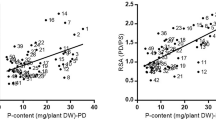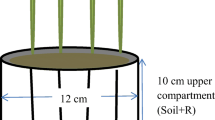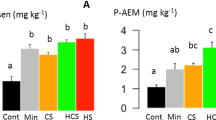Abstract
Aim
This study focused on P acquisition mechanisms of Hordeum spontaneum from P-impoverished soil by measuring plant growth, P acquisition and rhizosphere properties.
Methods
Two P-efficient genotypes (IS-22-30 and IS-22-25) and a P-inefficient genotype (IS-07-07) were subjected to a P supply of 0, 30 mg kg−1 (deficient P) and 60 mg kg−1 (sufficient P) in a rhizobag experiment. After 60 days, biomass, P concentration, and P uptake were analyzed. Changes in pH, P fractions and acid phosphatase activity in soil at different distances from the roots were determined, using a slicing technique.
Results
P-efficient genotypes showed greater biomass and plant P content, but lower plant P concentration than the P-inefficient genotype. The average seed P content was 113 and 176 μg P per seed of P-efficient genotypes and P-inefficient genotype, respectively. P-efficient genotypes showed P uptake of 3.0 and 7.9 mg pot−1 at 0 and 30 mg P kg−1; while that of P-inefficient genotype was 1.0 and 5.3 mg pot−1, respectively. Acid phosphatase activity was significantly enhanced in the soil-root interface and P-efficient genotypes demonstrated 54% greater activity of rhizosphere acid phosphatase than the P-inefficient genotype. Rhizosphere P fractions showed that P utilized by the two genotypes mainly came from H2O-Pi, NaHCO3-Pi, and NaOH-Pi, while the P-efficient genotypes markedly depleted NaHCO3-Po, NaOH-Po and HCl-Pi, and the depletion zone extended to 4 mm under P deficiency.
Conclusions
These results indicate the potential to sustain more growth and greater P acquisition by P-efficient genotypes of wild barley from P-deficient soil through changes of rhizosphere P fractions and enhancing rhizosphere acid phosphatase activity.







Similar content being viewed by others
References
Ansovini G (2006) Barley is the fourth cereal crop as to cultivated area. Informatore Agrario 62:25–31
Chen G, Liu Y, Ma J, Zheng Z, Wei Y, McIntyre CL, Zheng YL, Liu CJ (2013) A novel and major quantitative trait locus for Fusarium crown rot resistance in a genotype of wild barley (Hordeum spontaneum L.) PLoS One 8:e58040
Ciampitti IA, Picone LI, Rubio G, García FO (2011) Pathways of phosphorous fraction dynamics in field crop rotations of the pampas of Argentina. Soil Sci Soc Am J 75:918–926
Ciereszko I, Żebrowska E, Ruminowicz M (2011) Acid phosphatases and growth of barley (Hordeum vulgare L.) cultivars under diverse phosphorus nutrition. Acta Physiol Plant 33:2355–2368
Dissanayaka DMSB, Maruyama H, Masuda G, Wasaki J (2015) Interspecific facilitation of P acquisition in intercropping of maize with white lupin in two contrasting soils as influenced by different rates and forms of P supply. Plant Soil 390:223–236
George TS, Brown LK, Newton AC, Hallett PD, Sun BH, Thomas WT, White PJ (2011) Impact of soil tillage on the robustness of the genetic component of variation in phosphorus (P) use efficiency in barley (Hordeum vulgare L.) Plant Soil 339:113–123
Hassan HM, Hasbullah H, Marschner P (2013) Growth and rhizosphere P pools of legume-wheat rotations at low P supply. Biol Fertil Soils 49:41–49
Hassan HM, Marschner P, McNeill A, Tang C (2012) Growth, P uptake in grain legumes and changes in rhizosphere soil P pools. Biol Fertil Soils 48:151–159
He Z, Honeycutt CW, Cade-Menun BJ, Senwo ZN, Tazisong IA (2008) Phosphorus in poultry litter and soil: Enzymatic and nuclear magnetic resonance characterization. Soil Sci Soc Am J 72:1425–1433
He Z, Toor GS, Honeycutt CW, Sims JT (2006) An enzymatic hydrolysis approach for characterizing labile phosphorus forms in dairy manure under mild assay conditions. Bioresour Technol 97:1660–1668
Hedley MJ, Stewart JWB, Chauhan BS (1982) Changes in inorganic and organic soil phosphorus fractions induced by cultivation practices and by laboratory incubations. Soil Sci Soc Am J 46:970–976
Hinsinger P, Betencourt E, Bernard L, Brauman A, Plassard C, Shen J, Tang XY, Zhang FS (2011) P for two, sharing a scarce resource: soil phosphorus acquisition in the rhizosphere of intercropped species. Plant Physiol 156:1078–1086
Hinsinger P, Plassard C, Tang CX, Jaillard B (2003) Origins of root-mediated pH changes in the rhizosphere and their responses to environmental constraints: a review. Plant Soil 248:43–59
Hübner S, Höffken M, Oren E, Haseneyer G, Stein N, Graner A, Schmid K, Fridman E (2009) Strong correlation of wild barley (Hordeum spontaneum) population structure with temperature and precipitation variation. Mol Ecol 18:1523–1536
Jiménez-Cárceles FJ, Álvarez-Rogel J (2008) Phosphorus fractionation and distribution in salt marsh soils affected by mine wastes and eutrophicated water: a case study in se spain. Geoderma 144:299–309
Khan KS, Joergensen RG (2009) Changes in microbial biomass and P fractions in biogenic household waste compost amended with inorganic P fertilizers. Bioresour Technol 100:303–309
Lambers H, Raven JA, Shaver GR, Smith SE (2008) Plant nutrient-acquisition strategies change with soil age. Trends Ecol Evol 23:95–103
Lambers H, Shane MW, Cramer MD, Pearse SJ, Veneklaas EJ (2006) Root structure and functioning for efficient acquisition of phosphorus: matching morphological and physiological traits. Ann Bot 98:693–713
Li G, Li H, Leffelaar PA, Shen J, Zhang F (2015) Dynamics of phosphorus fractions in the rhizosphere of fababean (Vicia faba L.) and maize (Zea mays L.) grown in calcareous and acid soils. Crop Pasture Sci 66:608–611
Li YF, Luo AC, Wei XH, Yao XG (2008) Changes in phosphorus fractions, pH, and phosphatase activity in rhizosphere of two rice genotypes. Pedosphere 18:785–794
Liao X, Liu G, Hogue B, Li Y (2015) Phosphorus availability and environmental risks in potato fields in North Florida. Soil Use Manag 31:308–312
Liu J, Yang JJ, Cade-Menun BJ, Liang XQ, Hu YF, Liu CW, Zhao Y, Li L, Shi J (2013) Complementary phosphorus speciation in agricultural soils by sequential dfractionation, solution 31P nuclear magnetic resonance, and phosphorus K-edge X-ray absorption near-edge structure spectroscopy. J Environ Qual 42:1763–1770
Lu RK (Ed.) (1999) Analysis of soil agrochemistry. Chinese Agricultural Science and Technology Press, Beijing. (in Chinese)
Maltais-Landry G, Scow K, Brennan E (2014) Soil phosphorus mobilization in the rhizosphere of cover crops has little effect on phosphorus cycling in California agricultural soils. Soil Biol Biochem 78:255–262
Mehrvarz S, Chaichi MR (2008) Effect of phosphate solubilizing microorganisms and phosphorus chemical fertilizer on forage and grain quality of barely (Hordeum vulgare L.) Am Eurasian J Agric Environ Sci 3:855–860
Nadira UA, Ahmed IM, Wu F, Zhang G (2016) The regulation of root growth in response to phosphorus deficiency mediated by phytohormones in a tibetan wild barley accession. Acta Physiol Plant 38:1–11
Nadira UA, Ahmed IM, Zeng J, Bibi N, Cai S, Zhang FWG (2014) The changes in physiological and biochemical traits of Tibetan wild and cultivated barley in response to low phosphorus stress. Soil Sci Plant Nutr 60:832–842
Negassa W, Leinweber P (2009) How does the Hedley sequential phosphorus fractionation reflect impacts of land use and management on soil phosphorus: a review. J Plant Nutr Soil Sci 172:305–325
Nevo E, Chen G (2010) Drought and salt tolerances in wild relatives for wheat and barley improvement. Plant Cell Environ 33:670–685
Nuruzzaman M, Lambers H, Bolland MDA, Veneklaas EJ (2006) Distribution of carboxylates and acid phosphatase and depletion of different phosphorus fractions in the rhizosphere of a cereal and three grain legumes. Plant Soil 281:109–120
Ozturk L, Eker S, Torun B, Cakmak I (2005) Variation in phosphorus efficiency among 73 bread and durum wheat genotypes grown in a phosphorus-deficient calcareous soil. Plant Soil 269:69–80
Pagliari PH, Labosk CA (2013) Dairy manure treatment effects on manure phosphorus fractionation and changes in soil test phosphorus. Biol Fertil Soils 49:987–999
Pan XW, Li WB, Zhang QY, Li YH, Liu MS (2008) Assessment on phosphorus efficiency characteristics of soybean genotypes in phosphorus-deficient soils. Agric Sci China 7:958–969
Pearse SJ, Veneklaas EJ, Cawthray G, Bolland MD, Lambers H (2006) Triticum aestivum shows a greater biomass response to a supply of aluminium phosphate than Lupinus albus, despite releasing fewer carboxylates into the rhizosphere. New Phytol 169:515–524
Richardson AE, Barea JM, Mcneill AM, Prigent-Combaret C (2009) Acquisition of phosphorus and nitrogen in the rhizosphere and plant growth promotion by microorganisms. Plant Soil 321:305–339
Roboredo M, Fangueiro D, Lage S, Coutinho J (2012) Phosphorus dynamics in soils amended with acidified pig slurry and derived solid fraction. Geoderma 189:328–333
Rose TJ, Hardiputra B, Rengel Z (2010) Wheat, canola and grain legume access to soil phosphorus fractions differs in soils with contrasting phosphorus dynamics. Plant Soil 326:159–170
Rubio G, Faggioli V, Scheiner JD, Gutiérrez-Boem FH (2012) Rhizosphere phosphorus depletion by three crops differing in their phosphorus critical levels. J Plant Nutri Soil Sci 175:810–871
Sugihara S, Tomita Y, Nishigaki T, Kilasara M, Wasaki J, Funakawa S (2016) Effects of different phosphorus-efficient legumes and soil texture on fractionated rhizosphere soil phosphorus of strongly weathered soils. Biol Fertil Soils 52:367–376
Tabatabai MA, Bremner JM (1969) Use of p-nitrophenyl phosphate for assay of soil phosphatase activity. Soil Biol Biochem 1:301–307
Tiessen H, Moir JO (1993) Characterization of available P by sequential extraction. In: Carter MR (ed) Soil sampling and methods of analysis. Canadian Society of Soil Science. CRC, Lewis, pp 75–86
Tong D, Xu R (2012) Effects of urea and (NH4)2SO4 on nitrification and acidification of Ultisols from Southern China. J Environ Sci 24:682–689
Vandamme E, Rose T, Saito K, Jeong K, Wissuwa M (2016) Integration of P acquisition efficiency, P utilization efficiency and low grain P concentrations into P-efficient rice genotypes for specific target environments. Nutr Cycl Agroecosyst 104:1–15
Veneklaas EJ, Lambers H, Bragg J, Finnegan PM, Lovelock CE, Plaxton WC, Price CA, Scheible WR, Shane MW, White PJ, Raven JA (2012) Opportunities for improving phosphorus-use efficiency in crop plants. New Phytol 195:306–320
Verma S, Subehia SK, Sharma SP (2005) Phosphorus fractions in an acid soil continuously fertilized with mineral and organic fertilizers. Biol Fertil Soils 41:295–300
Waldrip HM, He ZQ, Erich MS (2011) Effects of poultry manure amendment on phosphorus uptake by ryegrass, soil phosphorus fractions and phosphatase activity. Biol Fertil Soils 47:407–418
Waldrip-Dail H, He Z, Erich MS, Honeycutt CW (2009) Soil phosphorus dynamics in response to poultry manure amendment. Soil Sci 174:195–201
Wang L, Liu K, Mao S, Li Z, Lu Y, Wang J, Liu YX, Wei YM, Zheng YL (2015) Large-scale screening for Aegilops tauschii tolerant genotypes to phosphorus deficiency at seedling stage. Euphytica 204:1–16
Wang X, Tang C, Guppy CN, Sale PWG (2008) Phosphorus acquisition characteristics of cotton (Gossypium hirsutum L.), wheat (Triticum aestivum L.) and white lupin (Lupinus albus L.) under P deficient conditions. Plant Soil 312:117–128
Xiao G, Li T, Zhang X, Yu H, Huang H, Gupta DK (2009) Uptake and accumulation of phosphorus by dominant plant species growing in a phosphorus mining area. J Hazard Mater 171:542–550
Xu J, Zhang XZ, Li TX, Yu HY, Ji L (2013) Screening of wild barley genotypes with high phosphorus use efficiency and their rhizosphere soil inorganic phosphorus fractions. Chin J Appl Ecol 24:2821–2830 (in Chinese)
Ye DH, Li TX, Yu HY, Chen GD, Zheng ZC, Zhang XZ, Li JX (2015) P accumulation of Polygonum hydropiper, soil P fractions and phosphatase activity as affected by swine manure. Appl Soil Ecol 86:10–18
Zhan XY, Liu WK, Hou YY, Zhang SX (2016) The influence of phosphorus sources on the growth and rhizosphere soil characteristics of two genotypes of wheat (Triticum Aestivum L.) Commun Soil Sci Plant 47:1078–1088
Zhang HW, Huang Y, Ye XS, Shi L, Xu FS (2009) Genotypic differences in phosphorus acquisition and the rhizosphere properties of Brassica napus in response to low phosphorus stress. Plant Soil 320:91–102
Zhang M, Jin ZQ, Zhao J, Zhang G, Wu F (2015) Physiological and biochemical responses to drought stress in cultivated and Tibetan wild barley. Plant Growth Regul 75:567–557
Acknowledgments
This study was supported by the National Natural Science Foundation of China (31401377), the Sichuan Science and Technology Support Project (2013NZ0029, 2013NZ0044) and the Key Project of Education Department in Sichuan Province (14ZA0002). The authors wish to thank the Triticeae Research Institute for providing seeds of wild barley and also appreciate professor Hans Lambers (University of Western Australia) for his useful comments regarding the contents and language of this manuscript.
Author information
Authors and Affiliations
Corresponding authors
Additional information
Responsible Editor: John Hammond.
Rights and permissions
About this article
Cite this article
Ye, D., Zhang, X., Li, T. et al. Phosphorus-acquisition characteristics and rhizosphere properties of wild barley in relation to genotypic differences as dependent on soil phosphorus availability. Plant Soil 423, 503–516 (2018). https://doi.org/10.1007/s11104-017-3530-4
Received:
Accepted:
Published:
Issue Date:
DOI: https://doi.org/10.1007/s11104-017-3530-4




